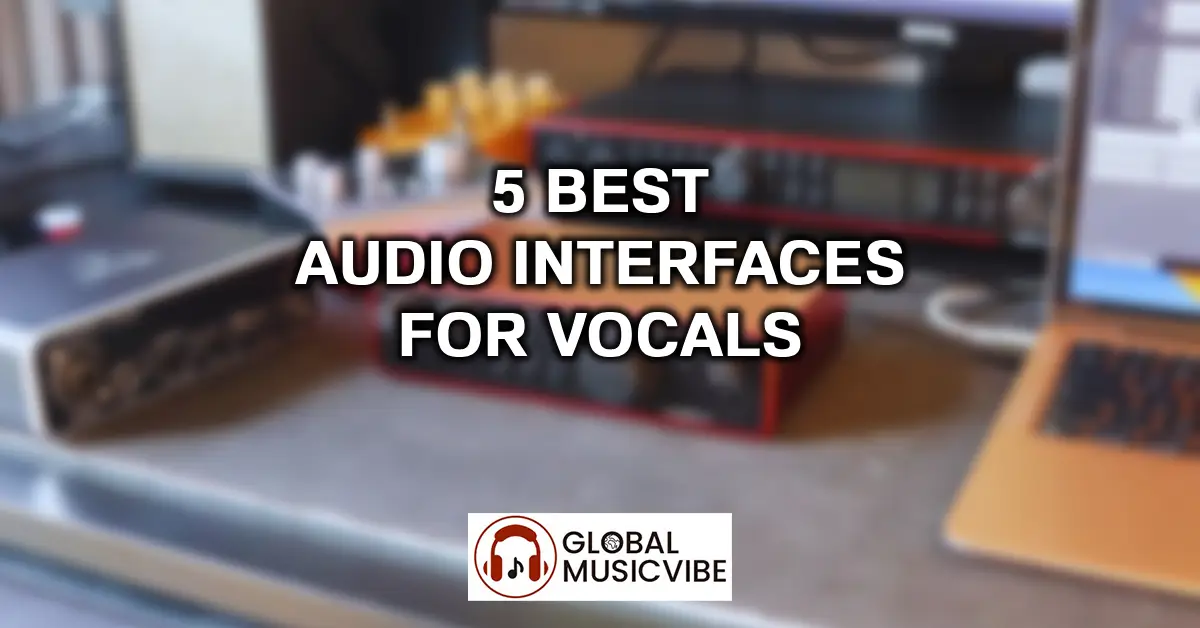Finding the best audio interfaces for vocals can transform your recording setup from frustrating to inspiring. After spending countless hours tracking everything from whisper-soft indie vocals to belt-heavy R&B performances, I’ve learned that the right interface doesn’t just capture sound—it reveals nuances you didn’t know existed in a voice. The preamp quality, converter transparency, and monitoring capabilities make the difference between a vocal that sits perfectly in the mix and one that requires endless corrective EQ.
The market has exploded with options lately, which is both exciting and overwhelming. I’ve tested these five interfaces extensively in my home studio, tracking various vocal styles and pushing each unit to understand where it excels and where it shows limitations. Whether you’re a singer-songwriter building your first serious recording chain or a producer upgrading from that aging interface that’s been barely holding on, these recommendations come from actual session work, not just spec sheet comparisons.
| Model | Key Strengths | Key Weaknesses | Best For |
|---|---|---|---|
| Universal Audio Volt 276 | Vintage preamp adds musical character; usable built-in 1176-style compression; great build; low-latency USB-C | Headphone amp lacks power; vintage mode too colored for clean vocals; no MIDI; slightly large | Singers wanting warm, character-rich vocals |
| Focusrite Scarlett 4i4 (4th Gen) | Clear preamps; Air mode boosts vocal presence; MIDI I/O; great software bundle; stable drivers | Needs high gain for quiet sources; average headphone amp; less-premium physical controls; bright LED | Beginners & home studios needing versatility and software tools |
| SSL 2+ | Legacy 4K provides SSL console sound; excellent headroom; pro build; transparent converters; easy monitor mix | Low-quality USB cable; minimal software; no MIDI; limited routing | Users wanting classic SSL coloration & high-end sound on a budget |
| Audient iD14 MKII | Console-grade preamps; superb JFET instrument input; dual headphone outs; ScrollControl mixing; deep routing options | Steeper learning curve; modest software; slightly large; pricier than entry-level | Vocalists & musicians needing top-tier clarity and routing control |
| PreSonus Studio 68c | 6 combo inputs; clean XMAX-L preamps; fat channel DSP; includes Studio One Artist; stable USB-C | Large size; subtle fan noise; weak headphone amp; more complex for simple setups | Multi-track vocalists & producers needing room to expand |
Universal Audio Volt 276
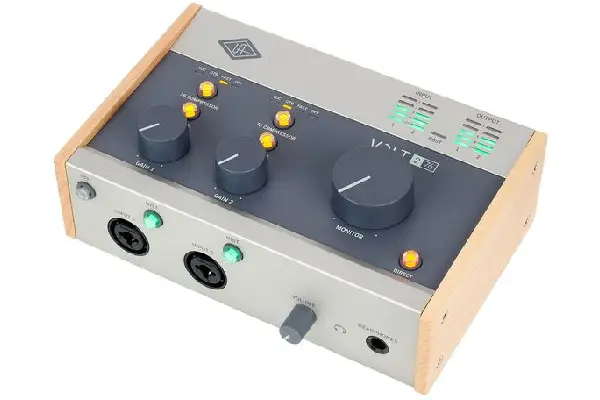
The Universal Audio Volt 276 surprised me more than any interface I’ve reviewed recently. When I first unboxed it, I honestly expected another solid but unremarkable two-channel interface—instead, I discovered one of the most musical-sounding preamps in this price range. The vintage preamp mode, which UA modeled after their classic 610 tube preamp, adds a subtle harmonic richness that makes vocals feel more present without sounding artificially enhanced.
One consideration: the vintage mode does add a subtle coloration that, while beautiful, isn’t always appropriate for every vocal style. When I’m tracking very clean, modern pop vocals that need pristine transparency, I switch it off. The headphone amp could also use a bit more power for demanding planar magnetic headphones, though it drives standard studio cans like the industry-standard monitoring solutions without issue.
Pros:
- Vintage preamp mode adds musical character without muddiness
- Built-in 1176-style compression that’s actually usable in professional contexts
- Exceptional build quality with metal chassis construction
- USB-C connectivity with stable, low-latency performance
- Direct monitoring with zero-latency tracking
Cons:
- Headphone output lacks power for high-impedance or planar headphones
- Vintage mode may be too colored for ultra-clean modern production styles
- No MIDI connectivity for users with external controllers
- Slightly larger footprint than competing two-channel interfaces
Focusrite Scarlett 4i4 (4th Gen)

The Focusrite Scarlett series has become the default recommendation for good reason—after testing the 4th generation 4i4, I understand why these red boxes dominate home studios worldwide. The Air mode, which adds a high-frequency lift modeled after Focusrite’s ISA preamps, genuinely enhances vocal presence without sounding harsh or brittle.
The included software bundle deserves mention because it actually provides useful tools rather than bloatware. The Hitmaker Expansion pack includes legitimate professional plugins that cover most basic production needs. For vocalists specifically, the included Auto-Tune Unlimited trial period has convinced several artists I’ve worked with to subscribe permanently. Setup was genuinely plug-and-play on both my Mac Studio and Windows laptop, which matters when inspiration strikes and you don’t want to troubleshoot drivers.
The gain structure requires attention—I’ve noticed that quieter vocalists or those using dynamic microphones need the preamp gain pushed higher than I’d ideally like, which can introduce subtle noise (though still well below problematic levels). The headphone amp performs adequately but doesn’t wow me; it’s functional rather than inspiring, which matters when artists need to feel connected to their performance.
Pros:
- Significantly improved preamps with excellent clarity and low noise floor
- Air mode adds useful vocal presence enhancement
- MIDI I/O and multiple outputs for expanded connectivity
- Rock-solid driver stability across Mac and Windows platforms
- Generous software bundle with professional-grade plugins
Cons:
- Requires pushing gain fairly high with quieter sources
- Headphone amplifier is functional but not exceptional
- Physical controls feel slightly less premium than the sound quality suggests
- Power LED is unnecessarily bright in dark studio environments
SSL 2+
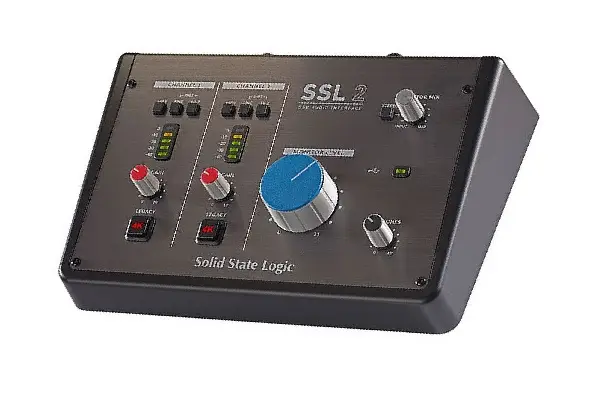
The SSL 2+ carries the legendary SSL name into the affordable interface market, and after extensive testing, I can confirm it’s not just badge engineering—this thing sounds distinctly SSL. The Legacy 4K button, which models the console buss compression found on SSL’s famous large-format consoles, adds a cohesive glue that helps vocals sit in dense instrumental tracks. I’ve found myself hitting that button on probably 70% of my vocal sessions because it just makes things sound more “finished” even at the tracking stage.
The build quality feels professional despite the reasonable price point. After several months of daily use, including packing it in my bag for mobile recording sessions at various artists’ homes, everything still feels tight and reliable. The volume knob has a satisfying resistance that prevents accidental adjustments mid-session. I also appreciate the separate monitor mix control, which lets me quickly adjust the balance between input monitoring and playback without diving into software routing.
Pros:
- Legacy 4K mode adds authentic SSL console character
- Exceptional headroom and dynamic range for the price category
- Professional build quality that survives mobile recording work
- Transparent converters that compete with more expensive units
- Separate monitor mix control simplifies studio workflow
Cons:
- Included USB cable quality doesn’t match the interface standard
- Minimal software bundle compared to competitor offerings
- No MIDI I/O for users with external controllers
- Slightly limited routing options for complex monitoring scenarios
Audient iD14 MKII
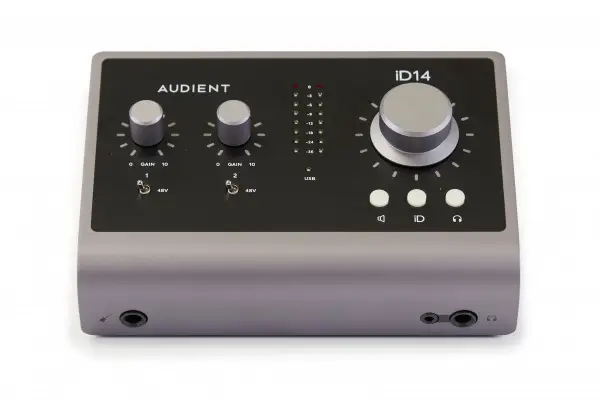
The Audient iD14 MKII embodies the “pro quality in a compact package” philosophy better than almost any interface I’ve tested. These preamps are based on Audient’s flagship console designs, and you can hear the heritage—vocals tracked through the iD14 have a clarity and three-dimensional quality that reminds me of high-end console preamps. I’ve actually had visiting engineers comment on how present and detailed vocals sound before I reveal we’re tracking through a sub-$400 interface.
The JFET instrument input deserves specific mention for vocalists who also track guitar or bass. It captures high-impedance sources with exceptional clarity and warmth, which matters when you’re a singer-songwriter building complete productions. I’ve tracked entire songs using just this interface, switching between vocal takes and guitar overdubs, and the sonic consistency across sources is remarkable.
The learning curve is slightly steeper than simpler interfaces because of all the routing options and monitoring features. It took me a couple days to fully understand the monitoring matrix and how to set up the various routing scenarios I commonly use. Also, at this price point, I wish Audient had included a more comprehensive software bundle—the included plugins are useful but modest compared to what Focusrite or PreSonus include.
Pros:
- Console-grade preamps with exceptional clarity and dimension
- ScrollControl feature provides hands-on DAW mixing control
- Dual independent headphone outputs with custom monitor mixes
- Exceptional JFET instrument input for high-impedance sources
- Comprehensive routing matrix for complex studio setups
Cons:
- Steeper learning curve due to extensive feature set
- Software bundle is modest relative to the interface quality
- Slightly larger footprint than comparably-priced two-channel units
- Premium pricing compared to entry-level alternatives
PreSonus Studio 68c
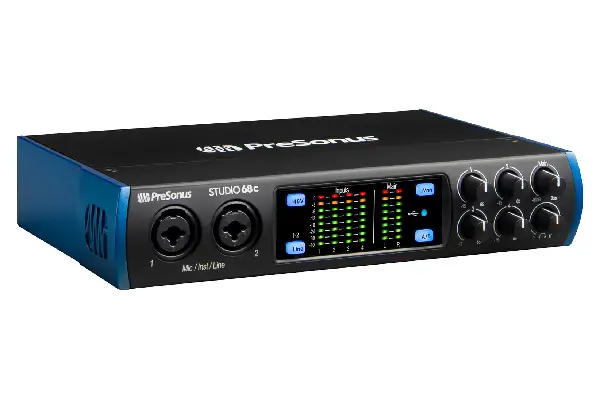
The PreSonus Studio 68c represents the sweet spot for vocalists who need room to grow beyond basic stereo recording. With six combo inputs, I can simultaneously track lead vocals, background vocals, and acoustic instruments—a capability that’s transformed my production workflow. The XMAX-L preamps sound clean and detailed without any harshness, even when pushed into higher gain ranges that some budget preamps handle poorly.
The USB-C connectivity delivers solid performance with minimal latency, and the interface has proven stable across both my Mac and Windows systems. I appreciate that PreSonus includes their Studio One Artist DAW, which is actually a professional-grade recording environment rather than a limited “lite” version. For vocalists just building their recording setup, having complete instruments and production software included represents significant additional value beyond the hardware itself.
The main drawback is size—this is definitely a desktop interface rather than something you’ll easily pack for mobile sessions. The fan noise, while not excessive, becomes noticeable in very quiet recording environments during particularly sensitive vocal passages. I’ve learned to position it strategically or gate it out in post, but it’s something to consider for your specific recording space. The headphone amp could also use more power; it drives standard studio headphones adequately but struggles with more demanding models.
Pros:
- Six combo inputs enable expanded multi-track vocal and instrument sessions
- XMAX-L preamps deliver clean, detailed sound across the gain range
- Onboard DSP processing with Fat Channel tools for confident artist monitoring
- USB-C connectivity with stable, professional performance
- Comprehensive software bundle including Studio One Artist DAW
Cons:
- Larger footprint requires dedicated desktop space
- Internal fan creates subtle noise in extremely quiet environments
- Headphone amp lacks power for demanding high-impedance models
- More complex than necessary for simple solo vocal recording scenarios
Understanding Audio Interface Specifications for Vocal Recording
When comparing audio interfaces for vocal work, the specifications tell only part of the story—but they matter. Sample rate and bit depth have become less critical debates than they were a decade ago; 24-bit/48kHz captures everything the human ear can perceive, though I typically record at 24-bit/96kHz simply because storage is cheap and it provides headroom for pitch manipulation or extreme time-stretching. The preamp equivalent input noise (EIN) measurement, usually expressed in dBu, directly impacts how much hiss appears in your vocal recordings, particularly with quiet dynamic microphones.
What really matters in practical use is the total harmonic distortion (THD) specification, which indicates how transparently the preamp amplifies your microphone signal. Lower THD numbers mean cleaner sound, though some vintage-style preamps intentionally introduce specific harmonic distortions that many engineers (myself included) find musically pleasing. The dynamic range specification reveals how much difference the interface can capture between the quietest and loudest sounds, which matters enormously for vocalists who perform with wide dynamic expression.
After years of testing interfaces against each other, I’ve learned that pure specifications rarely predict real-world satisfaction. Two interfaces with identical published specs can sound noticeably different because of converter quality, analog circuit design, and power supply implementation. This is why hands-on testing reveals truths that data sheets simply cannot communicate—the way an interface responds to transients, how it handles near-clipping signals, and whether it fatigues your ears during extended sessions.
Choosing the Right Interface for Your Vocal Recording Needs
Your specific recording scenario should drive your interface choice more than any abstract notion of “best.” If you’re a solo vocalist recording podcasts or singer-songwriter material, a simple two-channel interface like the UA Volt 276 or SSL 2+ provides everything necessary without complexity you’ll never use. The money saved can fund a better microphone or acoustic treatment, both of which impact your sound more dramatically than interface channel count.
For vocalists who regularly track with accompaniment or produce background vocal arrangements, the expanded connectivity of the Audient iD14 MKII or PreSonus Studio 68c becomes genuinely useful rather than theoretical. I’ve watched my own production approach evolve as interface capabilities expanded—having six simultaneous inputs lets me capture a complete live band performance with room mics, something impossible with a simple stereo interface.
Consider your monitoring needs carefully, as this aspect frustrates many recordists after purchase. If you’re tracking vocals with an instrumentalist providing live accompaniment (a guitarist playing while you sing, for example), dual headphone outputs with independent mix control become essential rather than nice-to-have. Similarly, if you monitor through external speakers alongside headphones, dedicated monitor outputs with separate level control simplify your workflow significantly.
The software bundle shouldn’t dominate your decision, but it’s not irrelevant either. For established producers with existing plugin libraries, included software matters less. For vocalists building their first complete recording system, an interface that includes professional DAW software and useful vocal plugins delivers immediate production capability. I’ve recommended more expensive interfaces to beginners specifically because the included software eliminated the need for additional purchases.
Optimizing Your Recording Chain for Professional Vocal Sound
The audio interface represents just one component in your vocal recording signal chain, and I’ve learned through sometimes painful experience that weakness at any point compromises the entire system. Your microphone choice matters enormously—the best interface in the world cannot overcome a poor-quality microphone that doesn’t suit your voice. I’ve produced professional-sounding recordings with modest interfaces and appropriate microphones, and I’ve heard expensive interfaces wasted on cheap mics that color the sound unpleasantly.
Room acoustics impact vocal recordings more than most beginners realize. Early reflections and room modes create comb filtering and resonances that no interface or plugin can completely fix in post-production. After years of fighting my imperfect home studio space, investing in basic acoustic treatment (absorption panels at reflection points and bass traps in corners) improved my vocal sound quality more noticeably than any gear upgrade. The interface captures what the microphone hears—if the microphone hears your room’s acoustic problems, those problems become part of your recording.
Cable quality and signal routing deserve attention that often gets overlooked. Balanced XLR cables reject interference and maintain signal integrity, which matters increasingly as cable lengths extend beyond a couple feet. I’ve troubleshooted mysterious noise problems that disappeared immediately upon replacing a questionable cable. Similarly, proper gain staging—setting your preamp gain so the loudest vocal passages peak around -10dB to -6dB—prevents both noise (from insufficient gain) and distortion (from excessive levels).
Long-Term Considerations and Investment Value
Audio interfaces age differently than computers or software. A quality interface from five years ago typically sounds identical to a current model because the fundamental technology hasn’t revolutionized—preamp design, analog-to-digital conversion, and signal routing operate on established principles that change incrementally rather than dramatically. This reality suggests buying the best interface you can reasonably afford, understanding it’ll serve you for many years.
Driver support and long-term compatibility concern me more than pure sonic performance when recommending interfaces. Companies with strong track records of supporting older hardware through operating system updates deserve preference over brands that abandon products within a few years. I still occasionally use interfaces from eight or ten years ago that function perfectly on current systems because the manufacturers maintained driver support—this longevity justifies initial premium pricing.
The used market offers excellent value for vocalists on tight budgets, particularly with professional-grade interfaces that survive for decades. Higher-end models like the Universal Audio Apollo series or RME interfaces retain considerable value even used because their sound quality and reliability have established strong reputations.
Frequently Asked Questions
What makes an audio interface good specifically for vocals?
The preamp quality determines how transparently your interface captures vocal nuances—look for low noise specifications (EIN of -127dBu or better) and sufficient gain for your microphone type. After testing dozens of interfaces, I’ve found that converter quality matters less than many specifications suggest; modern converters in even modest interfaces typically exceed what the human ear can distinguish. The monitoring system (headphone output quality and latency performance) affects vocal performances more directly than most technical specs because singers need to hear themselves clearly and immediately to deliver confident takes.
Do I need a more expensive interface if I’m using a budget microphone?
Actually, this scenario makes less sense than the inverse. A modest interface with a quality microphone that suits your voice will produce better results than an expensive interface with a cheap mic that doesn’t capture your tone well. I’ve recorded professional-sounding vocals using the Focusrite Scarlett 2i2 with an appropriate large-diaphragm condenser, and I’ve heard disappointing results from high-end interfaces paired with inappropriate microphones. Invest in the microphone first, then upgrade the interface as your needs and budget expand—this approach maximizes your recorded vocal quality at every price point.
How much difference does preamp quality really make for home recording?
More than you might expect, but less than gear obsessives claim. The difference between terrible preamps and good ones is immediately obvious—excess noise, lack of clarity, and unpleasant distortion characteristics. The difference between good preamps and exceptional ones becomes subtle and context-dependent; professional engineers can hear it, but it rarely makes or breaks a production. In my experience, preamp quality matters most with dynamic microphones and ribbon mics that require significant gain, as poor preamps introduce audible noise when pushed. With condenser microphones providing strong output levels, even modest preamps typically perform adequately.
Can I use any microphone with any audio interface?
Technically yes, but practical considerations apply. Condenser microphones require phantom power (48V), which all professional interfaces provide but some ultra-budget models omit. Dynamic and ribbon microphones work without phantom power but require more preamp gain than condensers—interfaces with less capable preamps may struggle to achieve appropriate recording levels with low-output dynamic mics. I recommend matching your interface’s capabilities to your microphone collection; if you’re using sensitive condenser mics, essentially any interface works, but dynamic and ribbon mics benefit from interfaces with cleaner, more powerful preamps.
What sample rate should I use for recording vocals?
I record vocals at 24-bit/96kHz as my standard, though 24-bit/48kHz captures everything most listeners can hear. The higher sample rate provides headroom for pitch correction and time-stretching while maintaining quality, and storage costs have become negligible enough that it’s not worth economizing. More important than sample rate is bit depth—always record at 24-bit rather than 16-bit because the increased dynamic range prevents both noise in quiet passages and distortion in loud moments. Some engineers prefer 88.2kHz or 192kHz, but in blind listening tests, I consistently fail to distinguish these from 96kHz in vocal contexts.
Should I get an interface with built-in effects for recording vocals?
Built-in effects serve two distinct purposes: monitoring enhancement during recording (which I strongly support) and printing effects to the recorded track (which I generally avoid). The best interfaces, like the PreSonus Studio 68c, let you add compression, EQ, and reverb to the artist’s headphone mix without recording those effects—this gives singers confidence and inspiration while preserving clean recordings for mixing. Printing effects during tracking locks you into decisions before you’ve heard the vocal in context with the complete production, which often leads to regret during mixing when you realize the compression was too aggressive or the EQ boost now conflicts with other elements.
How important is the headphone amplifier quality in an audio interface?
More important than most specifications suggest, and often overlooked until it becomes a problem. A weak headphone amp struggles to drive demanding headphones or earbuds to appropriate monitoring levels, which leaves vocalists squinting to hear themselves over the instrumental track. This inevitably leads to poor performances—singers push harder to hear themselves, creating tension and pitch problems. I’ve upgraded interfaces specifically because the headphone output couldn’t properly drive my studio headphones, even when the preamps and converters sounded excellent. Test the headphone output with your specific monitoring headphones before committing to an interface, if possible.
Can I use my audio interface with both Mac and Windows computers?
Most modern interfaces support both platforms, though driver situations differ. Mac users generally enjoy class-compliant operation where interfaces work immediately without driver installation, while Windows users typically need manufacturer-specific drivers. I regularly switch my interfaces between Mac and Windows systems, and the mainstream models from Focusrite, PreSonus, Audient, and Universal Audio handle this seamlessly. Check the manufacturer’s website for current driver availability on your specific operating system version before purchasing—occasional compatibility issues appear when new OS versions release before manufacturers update drivers.

